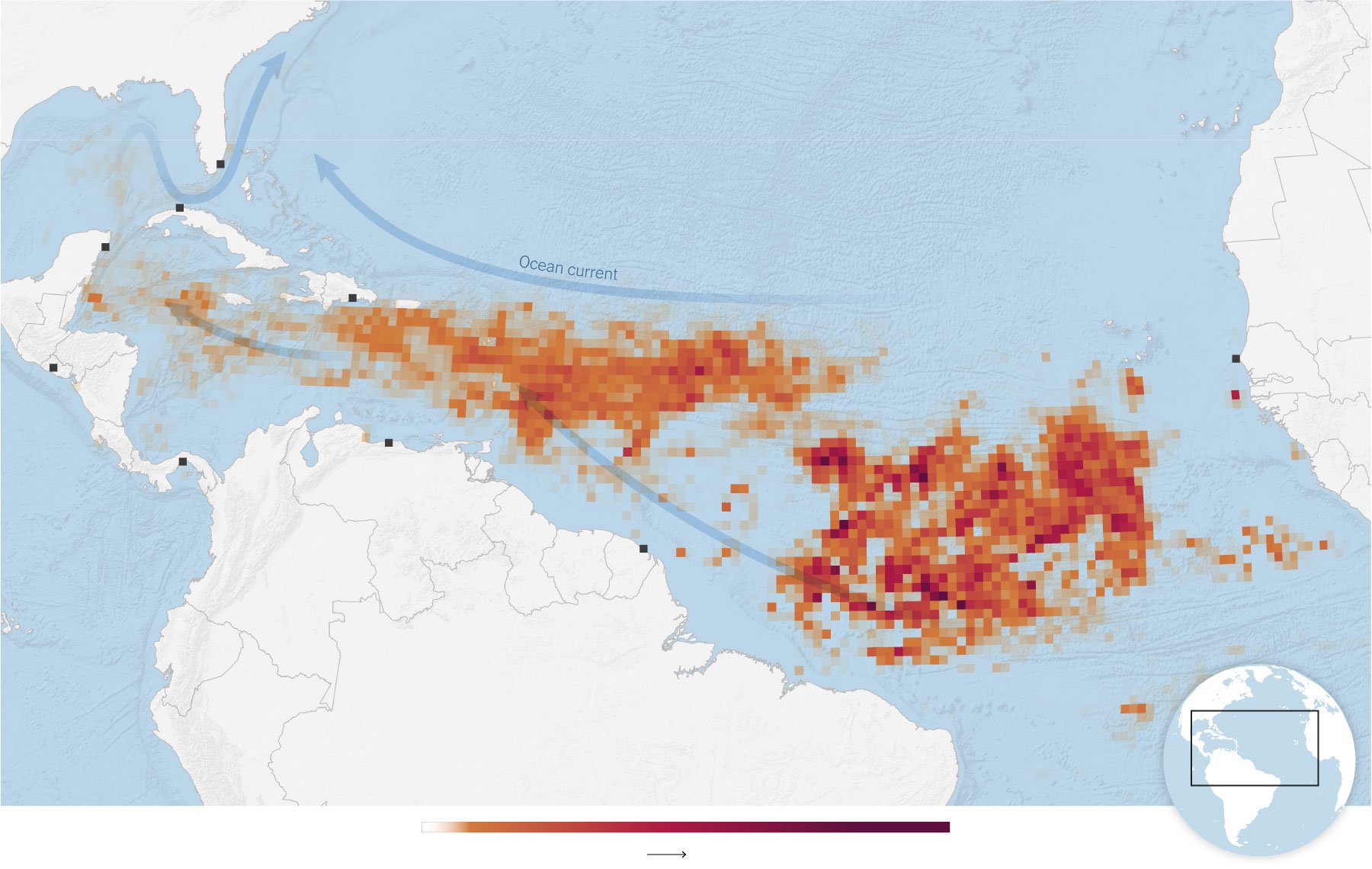Sargassum Creeps Closer to Coastlines
Yellow seaweed blobs are taking over the ocean but they are not what you think…
More than 13 million tons of yellow-brown seaweed called Sargassum was found in the Atlantic Ocean last month and has raised the attention and concern of scientists. These floating masses set a record in size in March, and Florida officials are preparing for them to hit coastlines. To put the size in perspective, the Sargassum has grown to be equal to the number of textile fabrics that America throws away each year.
These blobs of seaweed tend to form and build up in the Atlantic Ocean throughout the year. As spring and summer come about, ocean currents carry patches of Sargassum to different areas, such as eastern Florida and the Caribbean. However, due to the growing size, scientists are still determining how much it will wash ashore onto beaches this summer.
The Florida Keys has reported larger than usual amounts of seaweed this year. Brian Lapointe, a research professor at the Florida Atlantic University, is an expert in Sargassum and has studied seaweed for much of his career. He stated that he was amazed at the accumulation of seaweed that can currently be found offshore.
What is Sargassum?
Specifically, Sargassum is a genus of seaweed, which is a type of algae. It is a large seaweed that is often brown and turns red as it dries. Sargassum actually floats on top of the water and forms large masses similar to islands and tends to travel as it never attaches to the ocean floor.
Sargassum has been around for centuries, but since 2011, this algae has begun to bloom abnormally. These significant accumulations have been growing, but in 2023 they have reached concerning sizes. The reason for these abnormal blooms is suspected to be a result of excessive, nutrient-rich runoff from the places such as the Congo, the Amazon, and adjoining Mississippi rivers.
How much Sargassum is there?
The University of South Florida has found that the amount of Sargassum found in the Atlantic in February of 2023 was the second most recorded.
To determine the amount of Sargassum that is currently in the ocean, researchers at the Optical Oceanography Laboratory at the University of South Florida had to use satellite imagery. They had to use several sources, such as NASA’s Terra and Aqua satellites.
By using each pixel in the satellite imagery, the researchers were able to determine how much Sargassum is currently floating. The distinguished color of Sargassum allowed them to compare yellow-brown algae to the surrounding blue ocean. The immense amount of Sargassum growth can be seen in the image below, where one can see the sizable amount that the algae has bloomed.
Source: Optical Oceanography Laboratory at the University of South Florida College of Marine Science Note: Sargassum density detected via satellite imagery analysis by researchers at the University of South Florida.
The Effects of Sargassum
Officials in Florida are preparing for the sargassum belt to wash ashore on Florida’s Atlantic and Gulf coasts this summer. These beautiful destination beaches will be covered in Sargassum. Here the algae will decompose, creating unfavorable conditions for beachgoers.
The masses have already begun to wash up on beaches in Mexico and the south of Florida. As the Sargassum decomposes, the water quality will decrease, and there will be significant pollution on the beaches. The unbearable odor that the algae will emit can cause potential health risks to those exposed to it. The production of hydrogen sulfide and ammonia can irritate sensitive orifices such as the nose, throat, and eyes, as seen in a 2018 study in the Caribbean.
Are you looking to stay up to date with important news?
Join our Eco-activist newsletter! As a part of our eco-activist team, you will receive information to help you make sustainable choices while allowing us to hold corporations accountable for their effect on the ecosystem.
Our eco-activist membership is a great way to stay up to date with what is happening worldwide while supporting linear systems to be transformed.
You are helping the world by staying informed and becoming a part of something larger!
Together we can make the difference our earth needs.
Key Takeaways
More than 13 million tons of yellow-brown seaweed called Sargassum was found in the Atlantic Ocean last month and has raised the attention and concern of scientists.
To put the size in perspective, the Sargassum has grown to be equal to the number of textile fabrics America throws away each year.
Specifically, Sargassum is a genus of seaweed, which is a type of algae. It is a large seaweed that is often brown and turns red as it dries. Sargassum actually floats on top of the ocean and forms large masses similar to islands which tends to travel as it never attaches to the ocean floor.
Sargassum has been around for centuries, but since 2011, this algae has begun to bloom abnormally. These significant accumulations have been growing, but in 2023 they have reached concerning sizes. The reason for these abnormal blooms is suspected to be a result of excessive, nutrient-rich runoff from the places such as the Congo, the Amazon, and adjoining Mississippi rivers.
The masses have already begun to wash up on beaches in Mexico and the south of Florida. The odor that the algae will emit can cause potential health risks to those exposed to it.
As the Sargassum decomposes, the water quality will decrease, and there will be significant pollution on the beaches. The production of hydrogen sulfide and ammonia can irritate sensitive orifices such as the nose, throat, and eyes, as seen in a 2018 study in the Caribbean.



